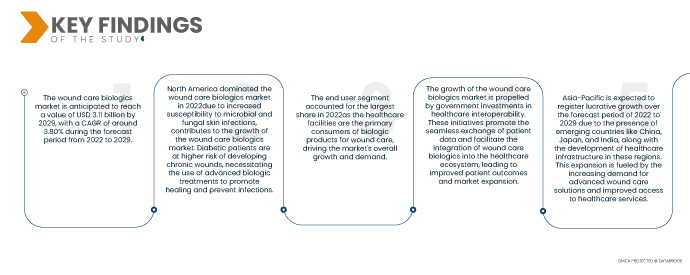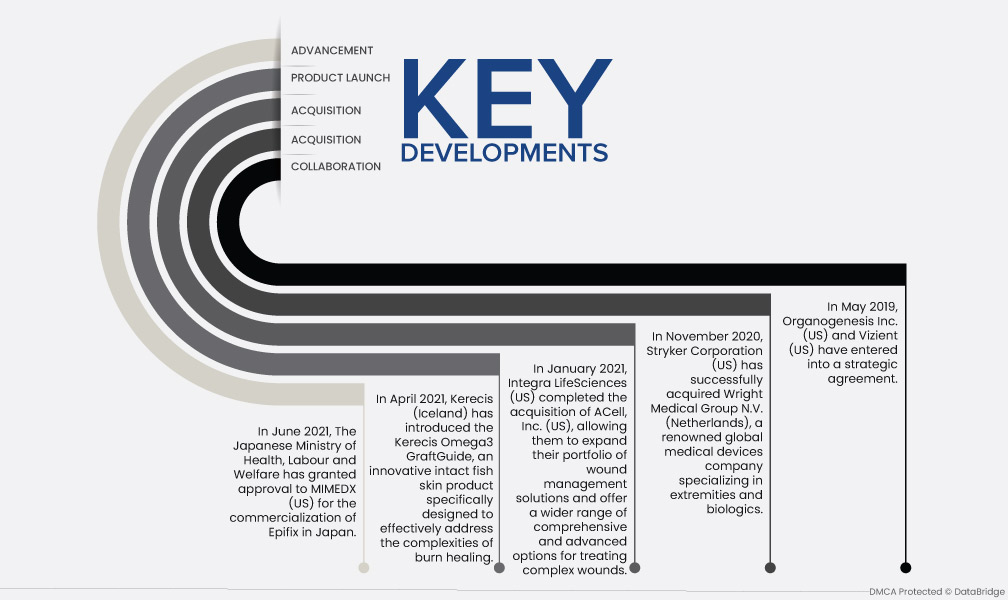Процесс заживления ран сложен и включает координацию и активацию различных элементов внутри и между клетками. К ним относятся коагуляция и отложение коллагена, эпителизация, рост фиброзной ткани, сокращение раны, воспаление, грануляция и ремоделирование. Биологические препараты для лечения ран, которые являются продуктами, созданными с помощью биологической инженерии, специально разработаны для лечения незаживающих ран нижних конечностей. Они находят применение при лечении диабетических язв стопы, пролежней, хирургических ран и венозных язв ног, среди прочего.
Полный отчет доступен по адресу https://databridgemarketresearch.com/reports/global-wound-care-biologics-market
Data Bridge Market Research анализирует, что рынок биологических препаратов для лечения ран оценивается в 2,23 млрд долларов США в 2021 году и, как ожидается, достигнет 3,11 млрд долларов США к 2029 году, регистрируя среднегодовой темп роста в 3,80% в прогнозируемый период с 2022 по 2029 год. Использование биологических препаратов для лечения ран может способствовать повышению экономической эффективности за счет ускорения заживления ран, снижения риска осложнений и потенциального сокращения продолжительности пребывания в больнице. Этот акцент на сдерживании затрат и улучшении результатов лечения пациентов способствовал принятию биологических препаратов для лечения ран.
Основные выводы исследования
Ожидается, что растущее бремя целевых заболеваний будет способствовать темпам роста рынка.
Растущая заболеваемость диабетом играет ключевую роль в росте рынка биологических препаратов для лечения ран. Диабет является основной причиной хронических ран, таких как язвы диабетической стопы, которые часто требуют передовых биологических методов лечения для ускорения заживления. Поскольку распространенность диабета продолжает расти во всем мире, растет спрос на эффективные решения для лечения ран, что стимулирует расширение рынка биологических препаратов для лечения ран с целью удовлетворения особых потребностей пациентов с диабетом.
Область отчета и сегментация рынка
Отчет Метрика
|
Подробности
|
Прогнозируемый период
|
2022-2029
|
Базовый год
|
2021
|
Исторические годы
|
2020 (Можно настроить на 2014-2019)
|
Количественные единицы
|
Выручка в млрд долл. США, объемы в единицах, цены в долл. США
|
Охваченные сегменты
|
Продукт (биологические заменители кожи, местные средства), тип раны (язвы, хирургические и травматические раны, ожоги), конечный пользователь (больницы, ASC, ожоговые центры и клиники по лечению ран)
|
Страны, охваченные
|
США, Канада и Мексика в Северной Америке, Германия, Франция, Великобритания, Нидерланды, Швейцария, Бельгия, Россия, Италия, Испания, Турция, Остальная Европа в Европе, Китай, Япония, Индия, Южная Корея, Сингапур, Малайзия, Австралия, Таиланд, Индонезия, Филиппины, Остальная часть Азиатско-Тихоокеанского региона (APAC) в Азиатско-Тихоокеанском регионе (APAC), Саудовская Аравия, ОАЭ, Южная Африка, Египет, Израиль, Остальной Ближний Восток и Африка (MEA) как часть Ближнего Востока и Африки (MEA), Бразилия, Аргентина и Остальная часть Южной Америки как часть Южной Америки.
|
Охваченные участники рынка
|
Smith & Nephew (Великобритания), Mölnlycke Health Care AB (Швеция), Integra LifeSciences Corporation (США), Wright Medical (США), MiMedx Group (США), Vericel Corporation (США), Anika Therapeutics (США), Osiris Therapeutics (США), Organogenesis (США), Kerecis (Исландия), Solsys Medical (США), ACell (США), Lavior Inc. (США). Marine Polymer Technologies, Inc. (США), Smith & Nephew (Великобритания), Mölnlycke Health Care AB (Швеция))
|
Данные, отраженные в отчете
|
Помимо информации о рыночных сценариях, таких как рыночная стоимость, темпы роста, сегментация, географический охват и основные игроки, рыночные отчеты, подготовленные Data Bridge Market Research, также включают в себя глубокий экспертный анализ, эпидемиологию пациентов, анализ воронки продаж, анализ ценообразования и нормативную базу.
|
Анализ сегмента:
Рынок биологических препаратов для лечения ран сегментирован по продукту, типу раны и конечному пользователю.
- На основе продукта рынок биологических препаратов для ухода за ранами сегментируется на биологические заменители кожи и местные средства. В 2022 году биологические заменители кожи сегментируются в глобальных биологических препаратах для ухода за ранами, поскольку они обеспечивают поддерживающую среду для роста клеток и регенерации тканей, способствуя более быстрому и эффективному заживлению ран.
В 2022 году сегмент биологических заменителей кожи будет доминировать на мировом рынке биологических средств для лечения ран
В 2022 году сегмент биологических заменителей кожи доминирует на рынке, он имеет различные применения в биопрепаратах для ухода за ранами. Они могут использоваться для лечения ожогов, хронических ран и крупных травматических повреждений. Эти трансплантаты обеспечивают временный или постоянный барьер, который защищает рану от инфекции, способствует пролиферации и миграции клеток и поддерживает регенерацию тканей.
- На основе типа раны рынок биопрепаратов для лечения ран представлен язвами, хирургическими и травматическими ранами и ожогами. В 2022 году сегмент язв доминирует и растет с самым высоким среднегодовым темпом роста в 11,4%, поскольку биопрепараты для лечения ран широко используются при лечении язв, таких как диабетические язвы стопы и венозные язвы ног.
- На основе конечного пользователя рынок биологических препаратов для лечения ран сегментируется на больницы, ASC, ожоговые центры и клиники по лечению ран. В 2022 году больничный сегмент будет расти с самым высоким среднегодовым темпом роста в 11,4%, поскольку они обеспечивают благоприятную среду для регенерации тканей, уменьшают воспаление и усиливают образование новых кровеносных сосудов.
В 2022 году сегмент больниц станет доминирующим конечным потребителем на мировом рынке биологических препаратов для лечения ран
В 2022 году больничный сегмент доминирует в сегменте приложений на мировом рынке биопрепаратов для лечения ран Биопрепараты для лечения ран играют важную роль в больницах при лечении сложных ран. Эти биопрепараты, такие как факторы роста, биоинженерные ткани и внеклеточные матрицы, используются для ускорения заживления хронических ран, диабетических язв, хирургических ран и пролежней.
Основные игроки
Компания Data Bridge Market Research выделяет следующие компании в качестве основных игроков на рынке биологических препаратов для лечения ран: Smith & Nephew (Великобритания), Mölnlycke Health Care AB (Швеция), Integra LifeSciences Corporation (США), Wright Medical (США), MiMedx Group (США).
Развитие рынка
- В июне 2021 года Министерство здравоохранения, труда и социального обеспечения Японии выдало компании MIMEDX (США) одобрение на коммерциализацию препарата Epifix в Японии.
- В апреле 2021 года компания Kerecis (Исландия) представила Kerecis Omega3 GraftGuide — инновационный продукт на основе цельной рыбьей кожи, специально разработанный для эффективного решения сложных проблем заживления ожогов.
- В январе 2021 года
- Компания Integra LifeSciences (США) завершила сделку по приобретению компании ACell, Inc. (США), что позволило ей расширить свой портфель решений по лечению ран и предложить более широкий спектр комплексных и передовых вариантов лечения сложных ран.
- В ноябре 2020 года Stryker Corporation (США) успешно приобрела Wright Medical Group NV (Нидерланды), известную глобальную компанию по производству медицинских приборов, специализирующуюся на конечностях и биологических препаратах. Это приобретение укрепляет позиции Stryker в этих областях, позволяя им предоставлять улучшенные медицинские решения пациентам по всему миру.
- В мае 2019 года Organogenesis Inc. (США) и Vizient (США) заключили стратегическое соглашение. Это партнерство позволяет Organogenesis расширить свой ассортимент передовых средств по уходу за ранами до более чем 3100 больниц, тем самым обеспечивая более широкий доступ к этим инновационным решениям для улучшения ухода за пациентами.
Региональный анализ
Географически в отчете о рынке биологических препаратов для лечения ран рассматриваются следующие страны: США, Канада и Мексика в Северной Америке, Германия, Франция, Великобритания, Нидерланды, Швейцария, Бельгия, Россия, Италия, Испания, Турция, остальные страны Европы в Европе, Китай, Япония, Индия, Южная Корея, Сингапур, Малайзия, Австралия, Таиланд, Индонезия, Филиппины, остальные страны Азиатско-Тихоокеанского региона (APAC) в Азиатско-Тихоокеанском регионе (APAC), Саудовская Аравия, ОАЭ, Южная Африка, Египет, Израиль, остальные страны Ближнего Востока и Африки (MEA) как часть Ближнего Востока и Африки (MEA), Бразилия, Аргентина и остальные страны Южной Америки как часть Южной Америки.
Согласно анализу Data Bridge Market Research:
Северная Америка будет доминирующим регионом на рынке биологических препаратов для лечения ран в прогнозируемый период 2022–2029 гг.
В 2022 году Северная Америка доминировала на рынке биологических препаратов для лечения ран, растущая распространенность язв диабетической стопы и повышенная восприимчивость к микробным и грибковым инфекциям кожи являются факторами, обуславливающими спрос на эффективные методы лечения. Эти состояния представляют собой значительные проблемы для здравоохранения из-за их влияния на качество жизни пациентов и потенциальных осложнений. Решение этих проблем требует инновационных подходов к лечению ран, сосредоточенных на профилактике, раннем выявлении и передовых методах лечения для смягчения бремени этих состояний и улучшения результатов лечения пациентов.
По оценкам, Азиатско-Тихоокеанский регион станет самым быстрорастущим регионом на рынке биологических препаратов для лечения ран в прогнозируемый период 2022–2029 гг.
В 2022 году ожидается рост Азиатско-Тихоокеанского региона в течение прогнозируемого периода из-за присутствия развивающихся стран, таких как Китай, Япония и Индия, в сочетании с их развивающейся инфраструктурой здравоохранения, что способствует росту потенциала в решении проблем диабетических язв стопы и кожных инфекций. Эти страны стали свидетелями экономического прогресса и увеличения инвестиций в здравоохранение, что создает возможности для улучшения доступа к медицинским услугам и передовым технологиям ухода за ранами. Этот прогресс позволяет лучше управлять этими состояниями и способствует разработке инновационных решений для удовлетворения растущих потребностей в здравоохранении в этих регионах.
Более подробную информацию об отчете о рынке биологических препаратов для лечения ран можно получить здесь – https://www.databridgemarketresearch.com/reports/global-wound-care-biologics-market












